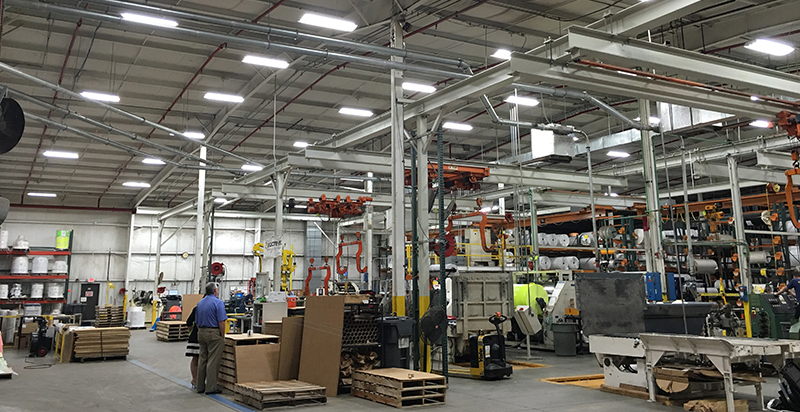Many manufacturing facilities are considering upgrading their existing factory lighting to more energy-efficient LED lighting to save on energy and maintenance costs. While the direct energy savings are absolutely notable, the effects of a lighting upgrade extend beyond only that. While considering an LED lighting upgrade, it is important to consider a total overhaul of your factory lighting. The gains produced may be hard to see at first, but once realized, they are significant and hard to ignore.

Effects of Factory Lighting on Morale
Employee’s morale should always be on managers’ minds because an employee that is happy and motivated will most likely be more productive and reliable. Today’s LED lighting color temperature is typically about 5000 Kelvins. This temperature is very similar to natural light and has been found to reduce melatonin production. This can result in employee alertness and reduce sleepiness and fatigue. Upgrading to brighter LED lighting improves the workplace by making it safer and look cleaner and more natural.
Safety Improvements with LED Lighting
Safety is an important consideration that will be improved with an LED lighting upgrade. If an employee cannot clearly see a hazard, accidents can happen. Workplace collisions can be prevented if proper factory lighting is in place to illuminate oncoming pedestrian or material handling equipment. It is also important to consider the upgrade to include specific workstation lighting. The improved workstation lighting can reduce machine and/or employee-related accidents by making hazards more apparent.
LED lighting is typically made of an array of tens or even hundreds of individual LED light chips with highly directed lensing. This causes very little shadowing. In addition, LED lighting maintains its brightness far longer than the typical HID lighting. Even though older lighting may still be working, it is operating at far less lighting output than when it was initially installed. This dim lighting can create safety hazards and lead to more workplace accidents.
Improvement in Quality Checks
Quality improvement always plays a big role in a production manager’s mindset. Improved LED lighting proves to be a valuable asset in inspection stations and quality control areas. As mentioned earlier, reduced shadowing can highlight quality defects in various parts and increases the ability to spot defects and quality deficiencies. LED lighting also enhances color recognition, which can improve quality control issues.
Many quality problems occur during the manufacturing or assembly process. LED lighting can reduce manufacturing errors since employees can recognize improper or missing components during the assembly operation. Staying alert is a crucial factor in operating machinery and product assembly. LED lighting helps prevent fatigue and therefore can lead to fewer mistakes and better quality output.

Health and Wellness Improvements
Poor lighting can lead to eye strain and causes headaches, tension, and eye discomfort. LED lighting can reduce these effects and possibly lead to better work attendance. If an employee is not feeling at their optimal, it can lead to poor productivity and production errors.
Increased Manufacturing Productivity
LED lighting in the workplace can improve assembly accuracy and potentially speed up operations. If sub-components can be found and oriented with more speed and accuracy, it will significantly increase productivity. As mentioned earlier, upgrading to LED lighting in your facility can improve overall alertness, make it easier to see clearly, reduce shadowing, and enhance color recognition during the assembly process, leading to increased inefficiencies and manufacturing productivity.
Conclusion
LED lighting is proven to be more energy efficient and longer lasting than traditional fluorescent, high pressure sodium, or metal halide lighting. As a result, most manufacturing facilities are evaluating LED lighting upgrades to reduce energy and maintenance costs. These savings can be quantified by projecting wattage reductions and the cost of bulbs and labor to replace old fixtures as they burn out. These savings alone can often justify any expense incurred with an LED lighting upgrade.
However, there are savings that are more difficult to quantify, but are extremely significant and can far outweigh the energy and maintenance savings associated with an LED upgrade. Consider how much profit could be realized if just a 1 percent increase in productivity could be gained with a brighter, LED lighting upgrade throughout a manufacturing facility. What about a 5 percent reduction in safety occurrences? How does that translate to insurance costs and workmen’s compensation claims? If overall product quality was improved by 3 percent, what does that mean to the cost incurred by defective products and customer quality claims? LED lighting can both improve quality during the production process and in the QC and inspection stations.
When considering upgrading to energy-efficient LED lighting, it’s imperative to factor in the not so obvious benefits and suddenly a marginally justifiable project becomes an easily justifiable one. It’s important to take the opportunity to not only replace existing fixtures and maintain previous light levels, but to significantly upgrade light levels to take full advantage of all the benefits LED lighting can have in the entire manufacturing environment.
Switching to LED lighting can allow your business to reap many benefits. Contact us today for a free energy cost savings assessment and see what GreenTech Solutions Group can do for your company.
Reposted with permission from Electro-Magtic LED Lighting blog


 LINKEDIN
LINKEDIN